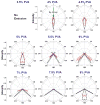Tuning Fluorescence Direction with Plasmonic Metal-Dielectric- Metal Substrates
- PMID: 24013521
- PMCID: PMC3762509
- DOI: 10.1021/jz301867b
Tuning Fluorescence Direction with Plasmonic Metal-Dielectric- Metal Substrates
Abstract
Controlling the emission properties of fluorophores is essential for improving the performance of fluorescence-based techniques in modern biochemical research, medical diagnosis, and sensing. Fluorescence emission is isotropic in nature, which makes it difficult to capture more than a small fraction of the total emission. Metal- dielectric-metal (MDM) substrates, discussed in this Letter, convert isotropic fluorescence into beaming emission normal to the substrate. This improves fluorescence collection efficiency and also opens up new avenues for a wide range of fluorescence-based applications. We suggest that MDM substrates can be readily adapted for multiple uses, such as in microarray formats, for directional fluorescence studies of multiple probes or for molecule-specific sensing with a high degree of spatial control over the fluorescence emission.
Section: Physical Processes in Nanomaterials and Nanostructures.
Conflict of interest statement
Notes: The authors declare no competing financial interest.
Figures







Similar articles
-
Directing fluorescence with plasmonic and photonic structures.Acc Chem Res. 2015 Aug 18;48(8):2171-80. doi: 10.1021/acs.accounts.5b00100. Epub 2015 Jul 13. Acc Chem Res. 2015. PMID: 26168343 Free PMC article.
-
Steering Fluorescence Emission with Metal-Dielectric-Metal Structures of Au, Ag and Al.J Phys Chem C Nanomater Interfaces. 2013 Aug 1;117(30):15798-15807. doi: 10.1021/jp4051066. J Phys Chem C Nanomater Interfaces. 2013. PMID: 25126154 Free PMC article.
-
Directional Emission from Metal-Dielectric-Metal Structures: Effect of Mixed Metal Layers, Dye Location and Dielectric Thickness.J Phys Chem C Nanomater Interfaces. 2015 Feb 12;119(6):3302-3311. doi: 10.1021/jp512174w. J Phys Chem C Nanomater Interfaces. 2015. PMID: 25844110 Free PMC article.
-
Nanomaterials in fluorescence-based biosensing.Anal Bioanal Chem. 2009 May;394(1):47-59. doi: 10.1007/s00216-009-2643-x. Epub 2009 Feb 17. Anal Bioanal Chem. 2009. PMID: 19221721 Review.
-
Aggregation of Metal-Nanoparticle-Induced Fluorescence Enhancement and Its Application in Sensing.ACS Omega. 2019 Dec 27;5(1):41-48. doi: 10.1021/acsomega.9b03560. eCollection 2020 Jan 14. ACS Omega. 2019. PMID: 31956749 Free PMC article. Review.
Cited by
-
Radiative decay engineering 6: fluorescence on one-dimensional photonic crystals.Anal Biochem. 2013 Nov 1;442(1):83-96. doi: 10.1016/j.ab.2013.07.021. Epub 2013 Jul 27. Anal Biochem. 2013. PMID: 23896462 Free PMC article.
-
Directing fluorescence with plasmonic and photonic structures.Acc Chem Res. 2015 Aug 18;48(8):2171-80. doi: 10.1021/acs.accounts.5b00100. Epub 2015 Jul 13. Acc Chem Res. 2015. PMID: 26168343 Free PMC article.
-
Radiative decay engineering 7: Tamm state-coupled emission using a hybrid plasmonic-photonic structure.Anal Biochem. 2014 Jan 15;445:1-13. doi: 10.1016/j.ab.2013.10.009. Epub 2013 Oct 14. Anal Biochem. 2014. PMID: 24135654 Free PMC article.
-
Surface-plasmon induced polarized emission from Eu(III)--a class of luminescent lanthanide ions.Chem Commun (Camb). 2014 Aug 18;50(64):9010-3. doi: 10.1039/c4cc03633f. Chem Commun (Camb). 2014. PMID: 24984065 Free PMC article.
-
Steering Fluorescence Emission with Metal-Dielectric-Metal Structures of Au, Ag and Al.J Phys Chem C Nanomater Interfaces. 2013 Aug 1;117(30):15798-15807. doi: 10.1021/jp4051066. J Phys Chem C Nanomater Interfaces. 2013. PMID: 25126154 Free PMC article.
References
-
- Jun YC, Huang KCY, Brongersma ML. Plasmonic Beaming and Active Control Over Fluorescent Emission. Nat Commun. 2011;283:1–6. - PubMed
-
- Aouani H, Mahboub O, Devaux E, Rigneault H, Ebbesen TW, Wenger J. Plasmonic Antennas for Directional Sorting of Fluorescence Emission. Nano Lett. 2011;11:2400–2406. - PubMed
-
- Schuller JA, Barnard ES, Cai W, Jun YC, White JS, Brongersma ML. Plasmonics for Extreme Light Concentration and Manipulation. Nat Mater. 2010;9:193–204. - PubMed
Grants and funding
LinkOut - more resources
Full Text Sources
Other Literature Sources

